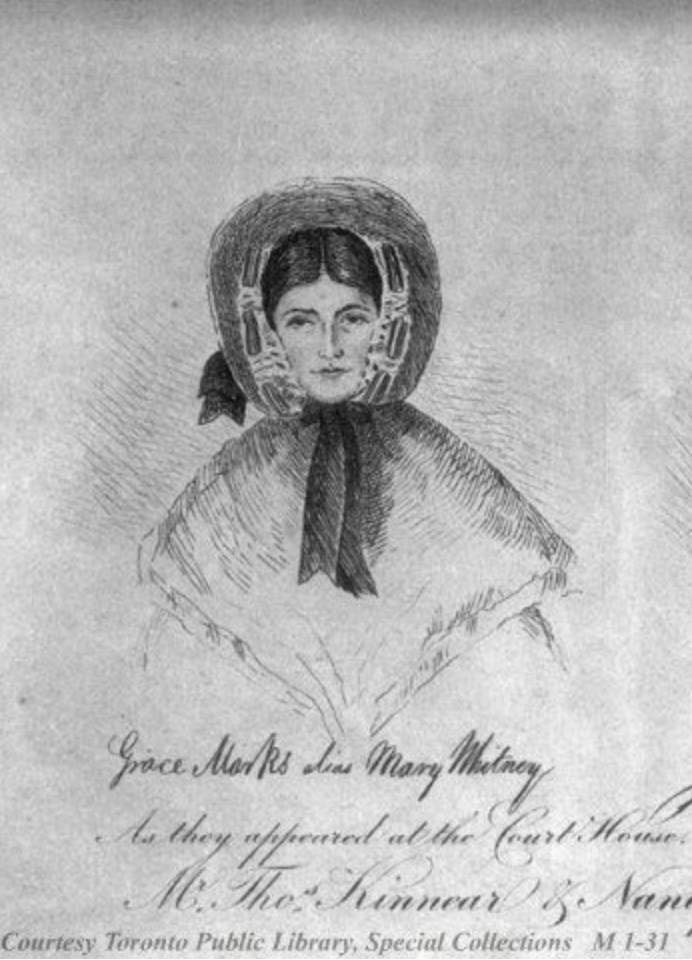Credit: Grace Marks, sketched in 1843. Retrieved from WikiMedia Commons.
Sneha Mantri
The facts are sparse. Grace Marks was born in Ireland around 1828, emigrated to Canada in 1840 with her family, and by 1843, aged barely fifteen, was sentenced to death for the murder of her employer Thomas Kinnear. Her story was sensationalized in the newspaper-tabloids of the day, then promptly forgotten. More than a century later, a celebrated Canadian author wrote a novel about the events, and two decades after that, a celebrated online streaming service adapted that novel into a critically acclaimed miniseries. Like a game of telephone, and like her own memories, Grace’s story seems to shift slightly with each repetition. The dynamic nature of Alias Grace illustrates how truth in story depends not only on the teller but also on the recipient.
Both Margaret Atwood’s novel and the CBC/Netflix miniseries rely on a frame narrative, in which a fictional young physician, Simon Jordan, attempts through a series of clinical interviews to discover the true character of Grace Marks. Simon is a staunch empiricist, believing that he can uncover the truth of Grace’s experience as one would peel back the layers of an onion. In the novel, Simon is something of a stand-in for the reader (though Atwood complicates this notion as the novel progresses), while in the miniseries, the viewer is more closely allied with Grace. This changes the developing relationship between Simon and Grace as the story unfolds.
In the novel, Simon first sees Grace standing in the light of her prison cell as “a nun in a cloister, a maiden in a towered dungeon” (Atwood 59). Grace’s physical appearance is “as it should be” (Atwood 59), drawing on both Simon’s chivalric notions and his experience with “many hysterics at the Salpêtrière [Hospital] in Paris” Grace (Atwood 59). This is a setting and role he is prepared for: Grace as “the cornered woman” (Atwood 59) and himself as the “last minute champion” (Atwood 59) who will save her from the evils of prison by asserting her innocence. In other words, he imagines her in a context entirely familiar to him.
Yet as soon as Grace steps forward, she becomes “a different woman” (Atwood 59). Suddenly, she is “straighter, taller, more self-possessed” (Atwood 59). Grace’s movement forward asserts her independence and Selfhood against Simon’s attempts to define her on his terms. Rather than submitting to his scientific gaze, Grace’s eyes “frankly assess him…as if it were he, and not she, who was under scrutiny” (Atwood 60). Grace reverses Simon’s clinical gaze, demonstrating that the relationship between Self and Other is not unidirectional but that patient and physician create and seek to understand one another.
By contrast, Alias Grace the miniseries gives the reader a far different introduction to Grace Marks. As she stands in front of a mirror, Grace, played exquisitely by Sarah Gadon, tries on different personas. She is by turns demonic, pliable, domestic, idiotic, a woman with ideas above her station. As the voiceover tells us, these are all labels applied to Grace by others, and she demonstrates how easily she can slip from one character to another. Simon Jordan’s clinical gaze has been replaced by our own gaze as viewer, as we watch Grace watch herself. The text of the voiceover is largely taken from the novel’s third chapter, but by opening with this emphasis on performance, the miniseries immediately casts doubt on Grace’s testimony. This heightens the suspense for the viewer—throughout Grace’s tale, we think back to that opening scene and wonder if she is telling the truth. In shifting the story’s focus from the Grace-Simon dynamic to the Grace-viewer dynamic, the intersubjectivity of the novel expands to explicitly include the viewer.
Like the novel, the miniseries resists providing an easy answer to the question of Grace’s culpability. Whereas the novel relies on contradictory outside testimony and newspaper clippings to complicate Simon’s understanding of Grace, the series tightens the story’s focus to the relationship between Grace and Simon, almost to the exclusion of others. In so doing, it emphasizes the growing relationship between Grace and Simon. In one memorable scene, Simon becomes visibly uncomfortable as Grace recounts the harrowing sea voyage that brought her to Canada. As she describes the stuffy air of the ship’s hold where they traveled, Simon abruptly rises and opens the window, illustrating the extent to which Grace’s story affects him. Grace’s feelings are more circumspect, but are betrayed by small smiles and the letter she writes him years later, which closes both the novel and the series.
The relationship between Simon Jordan and Grace Marks, or between the viewer and Grace Marks, recalls intersubjectivity in the clinical encounter. Both the novel and the show demonstrate that detached clinical observation is insufficient in connecting with the Other; in order to develop a true bond, one must be willing to give of oneself. Simon and Grace come to know something of each other’s lives, yet the issue of Grace’s state during the Kinnear-Montgomery murders remains unresolved. Indeed, as the story progresses, Grace becomes increasingly complex, and the line between reality and theatricality, between Self and Other, is often blurred. In a sense, Grace is created only by those who speak with her, and each one sees a different Grace. In both novel and drama, Alias Grace deliberately resists giving an answer to the question of Grace’s culpability. In adhering to that ambiguity, it asserts the unknowable Other.
Works Cited
Atwood, Margaret. Alias Grace. Anchor Books, 1997.
Alias Grace. Directed by Mary Harron. Netflix, 2017.


